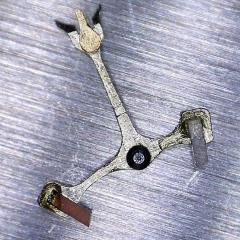Hairspring holder.
-
Recently Browsing
- No registered users viewing this page.
-
Topics
-
Posts
-
Thanks again for your help. I have cleaned everything, apart from the mainsprings and barrels, and it's all nice and shiny. I have cleaned the holes with dry peg wood sticks. I haven't oiled anything yet. I have temporarily reassembled the going train and am very pleased to say that for the past 2 hours it has been ticking nicely. The replacement hourwheel which I referred to in my original post fits very loosely but nonetheless seems to engage and travel round perfectly well. So now I need to reassemble the strike train. Is there a set of diagrams which I can refer to for this? The strike wheels have dots marked on them which must be designed to help but I don't know which one aligns with which.
-
I filed a Seiko regulator wrench out of a screwdriver.
-
It's a so-called split stem. I'm guessing the spring is for the screw-down crown operation. I don't think I've ever seen both features together before, but it looks complete. If I'm right, the crown will have an inner thread and the tube a matching external thread. Replace the seals if you want it to be watertight. If you can compress the spring far enough, slide the two parts of the stem together sideways. If that doesn't work, you should be able to push them back together end to end, the opposite of how you pulled them apart.
-
I have purchased some lume to redo the hands. Luckily I have another watch with the incorrect hands lume that I can practice on first. The colour change is also matching the same colour so I can use these hands to validate the colour is correct before I remove the lume from the Omega hands. I purchased from Nocti Lumina after seeing Marshall use them on WWR and they were great. Not only did they help me pick the perfect colour but they also very kindly gave me some different coloured lume so I can tweak the colour I have if I need, but they are confident the standard colouris going to do the job.
-
Welcome to the forum Michael. I hope you have a large workspace, or this phase: will be over very quickly.
-






Recommended Posts
Join the conversation
You can post now and register later. If you have an account, sign in now to post with your account.
Note: Your post will require moderator approval before it will be visible.